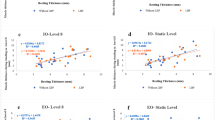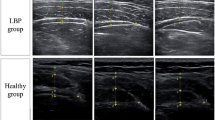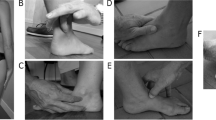Abstract
Within the context of low back pain, the measurement of deep abdominal anticipatory postural adjustments (APAs) during rapid limb movement has received much interest. There is dispute about the association between APAs and back pain. Moreover, there is limited evidence examining compensatory postural adjustments (CPAs) in back pain. This study examined the relationship between APAs and CPAs with pain reported in the low back during 2 h of prolonged standing. Twenty-six participants with no history of severe back pain performed 2-h prolonged standing. APAs and CPAs of the deep abdominal muscles (transverse abdominis/internal obliques) were measured by surface electromyography during rapid shoulder flexion and extension. APAs and CPAs measured pre-standing revealed symmetrical anticipatory activity, but an asymmetry between the different sides of the abdominal wall for CPAs. APAs and CPAs measured pre-standing were not associated with pain reported during standing. For the whole group, APA amplitudes were reduced post-standing during shoulder flexion (p = 0.005). Pain reported during standing was associated with the changes in APA amplitudes post-standing (rs = 0.43, p = 0.002). These findings support previous research using hypertonic saline injections to induce back pain that showed reduced APA amplitudes, and extends findings to suggest pain does not effect compensatory postural adjustments.





Similar content being viewed by others
References
Alexandrov A, Frolov A, Horak F, Carlson-Kuhta P, Park S (2005) Feedback equilibrium control during human standing. Biol Cybern 93:309–322
Allison GT (2003) Trunk muscle onset detection technique for EMG signals with ECG artefact. J Electromyogr Kinesiol 13:209–216
Allison G, Morris S, Lay B (2008) Feedforward responses of transversus abdominis are directionally specific and act asymmetrically: implications for core stability theories. J Orthopaedic Sports Phys Ther 38:228–237
Aruin AS, Latash ML (1995) Directional specificity of postural muscles in feed-forward postural reactions during fast voluntary arm movements. Exp Brain Res 103:323–332
Belen’kii V, Gurfinkel V, Pal’tsev E (1967) Control elements of voluntary movements. Biofizika 12:135–141
Bouisset S, Zattara M (1981) A sequence of postural adjustments precedes voluntary movement. Neurosci Lett 22:263–270
Brooks C, Kennedy S, Marshall PWM (2012) Specific trunk and general exercise elicit similar changes in anticipatory postural adjustments in patients with chronic low back pain: a randomized controlled trial. Spine 37:E1543–E1550
Farina D, Merletti R, Enoka R (2004) The extraction of neural strategies from the surface EMG. J Appl Physiol 96:1486–1495
Farina D, Cescon C, Negro F, Enoka R (2008) Amplitude cancellation of motor-unit action potentials in the surface electromyogram can be estimated with spike-triggered averaging. J Neurophysiol 100:431–440
Gregory DE, Callaghan JP (2008) Prolonged standing as a precursor for the development of low back discomfort: an investigation of possible mechanisms. Gait Posture 28:86–92
Gregory DE, Brown SHM, Callaghan JP (2008) Trunk muscle responses to suddenly applied loads: do individuals who develop discomfort during prolonged standing respond differently? J Electromyogr Kinesiol 18:495–502
Gubler D, Mannion AF, Schenk P et al (2010) Ultrasound tissue doppler imaging reveals no delay in abdominal muscle feed-forward activity during rapid arm movements in patients with chronic low back pain. Spine 35:1506–1513
Henry S, Fung J, Horak F (1998) EMG responses to maintain stance during multidirectional surface translations. J Neurophysiol 80:1939–1950
Hodges PW (2001) Changes in motor planning of feedforward postural responses of the trunk muscles in low back pain. Exp Brain Res 141:261–266
Hodges P, Richardson C (1996) Inefficient muscular stabilisation of the lumbar spine associated with low back pain: a motor control evaluation of transversus abdominus. Spine 21:2640–2650
Hodges P, Richardson C (1997a) Contraction of the abdominal muscles associated with movement of the lower limb. Phys Ther 77:132–144
Hodges P, Richardson CA (1997b) Feedforward contraction of transversus abdominis is not influenced by the direction of arm movement. Exp Brain Res 114:362–370
Hodges P, Richardson C (1999) Altered trunk muscle recruitment in people with low back pain with upper limb movement at different speeds. Arch Phys Med Rehabil 80:1005–1012
Hodges P, Moseley GL, Gabrielsson A (2003) Acute experimental pain changes postural recruitment of the trunk muscles in pain-free humans. Exp Brain Res 151:262–271
Huskisson EL (1974) Measurement of pain. Lancet 9:1127–1131
Keenan K, Farina D, Merletti R, Enoka R (2006) Amplitude cancellation reduces the size of motor unit action potentials averaged from the surface EMG. J Appl Physiol 100:1928–1937
Kelly A-M (1998) Does the clinically significant difference in visual analog scale pain scores vary with gender, age, or cause of pain? Acad Emerg Med 5:1086–1090
Lariviere C, Butler H, Sullivan MJL, Fung J (2013) An exploratory study on the effect of pain interference and attentional interference on neuromuscular responses during rapid arm flexion movements. Clin J Pain 29:265–275
Latash ML (2008) Neurophysiological basis of movement. Human Kinetics, Champaign, IL
Mannion AF, Pulkovski N, Schenk P et al (2008) A new method for the noninvasive determination of abdominal muscle feedforward activity based on tissue velocity information from tissue Doppler imaging. J Appl Physiol 104:1192–1201
Marshall PWM, Murphy BA (2003) The validity and reliability of surface EMG to assess the neuromuscular response of the abdominal muscles to rapid limb movement. J Electromyogr Kinesiol 13:477–489
Marshall PWM, Murphy BA (2006) The relationship between active and neural measures in patients with nonspecific low back pain. Spine 31:E518–E524
Marshall PWM, Murphy BA (2008) Muscle activation changes following exercise rehabilitation for chronic low back pain. Arch Phys Med Rehabil 89:1305–1313
Marshall PWM, Murphy BA (2010) Delayed abdominal muscle onsets and self-report measures of pain and disability in chronic low back pain. J Electromyogr Kinesiol 20:833–839
Marshall PWM, Patel H, Callaghan JP (2011) Gluteus medius strength, endurance, and coactivation in the development of low back pain during prolonged standing. Hum Mov Sci 30:63–73
Masse-Alarie H, Flamand VH, Moffet H, Schneider C (2012) Corticomotor control of deep abdominal muscles in chronic low back pain and anticipatory postural adjustments. Exp Brain Res 218:99–109
Mok NW, Brauer SG, Hodges PW (2011) Postural recovery following voluntary arm movement is impaired in people with chronic low back pain. Gait Posture 34:97–102
Morris SL, Lay B, Allison GT (2013) Transversus abdominis is part of a global not local muscle synergy during arm movement. Hum Mov Sci. doi:10.1016/j.humov.2012.12.011
Nelson-Wong E, Callaghan JP (2010a) Changes in muscle activation patterns and subjective low back pain ratings during prolonged standing in response to an exercise intervention. J Electromyogr Kinesiol 20:1125–1133
Nelson-Wong E, Callaghan JP (2010b) Is muscle co-activation a predisposing factor for low back pain development during standing? A multifactorial approach for early identification of at-risk individuals. J Electromyogr Kinesiol 20:256–263
Nelson-Wong E, Gregory DE, Winter DA, Callaghan JP (2008) Gluteus medius muscle activation patterns as a predictor of low back pain during standing. Clin Biomech 23:545–553
Park S, Horak F, Kuo A (2004) Postural feedback responses scale with biomechanical constraints in human standing. Exp Brain Res 154:417–427
Raftry SM, Marshall PWM (2012) Does a ‘tight’ hamstring predict low back pain reporting during prolonged standing. J Electromyogr Kinesiol 22:407–411
Revill SI, Robinson JO, Rosen M, Hogg MIJ (1976) The reliability of a linear analogue for evaluating pain. Anaesthesia 31:1191–1198
Santos MJ, Kanekar N, Aruin AS (2010) The role of anticipatory postural adjustments in compensatory control of posture: 1. Electromyographic analysis. J Electromyogr Kinesiol 20:388–397
Silfies SP, Mehta R, Smith SS, Karduna AR (2009) Differences in feedforward trunk muscle activity in subgroups of patients with mechanical low back pain. Arch Phys Med Rehabil 90:1159–1169
Summers S (2001) Evidence-based practice part 2: reliability and validity of selected acute pain instruments. J Perianesth Nurs 16:35–40
Tsao H, Druitt TR, Schollum TM, Hodges PW (2010) Motor training of the lumbar paraspinal muscles induces immediate changes in motor coordination in patients with recurrent low back pain. J Pain 11:1120–1128
Vasseljen O, Unsgaard-Tondel M, Westad C (2012) Effect of core stability exercises on feed-forward activation of deep abdominal muscles in chronic low back pain: a randomized controlled trial. Spine 37:1101–1108
Acknowledgments
The author acknowledges Dr. Simon Green and Dr. Jason Siegler for their comments on the manuscript.
Conflict of interest
The author declares no financial relationship relevant to this article and no conflict of interest.
Author information
Authors and Affiliations
Corresponding author
Rights and permissions
About this article
Cite this article
Marshall, P.W.M., Romero, R. & Brooks, C. Pain reported during prolonged standing is associated with reduced anticipatory postural adjustments of the deep abdominals. Exp Brain Res 232, 3515–3524 (2014). https://doi.org/10.1007/s00221-014-4040-8
Received:
Accepted:
Published:
Issue Date:
DOI: https://doi.org/10.1007/s00221-014-4040-8




